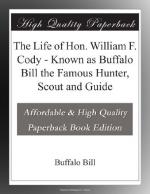At Coon Creek I dismounted and led the mule by the bridle down to the water, where I took a drink, using my hat for a dipper. While I was engaged in getting the water, the mule jerked loose and struck out down the creek. I followed him in hopes that he would catch his foot in the bridle rein and stop, but this he seemed to have no idea of doing. He was making straight for the wagon road, and I did not know what minute he might run into a band of Indians. He finally got on the road, but instead of going back toward Fort Dodge, as I naturally expected he would do, he turned eastward toward Fort Larned, and kept up a little jog trot just ahead of me, but would not let me come up to him, although I tried it again and again. I had my gun in my hand, and several times I was strongly tempted to shoot him, and would probably have done so had it not been for fear of bringing Indians down upon me, and besides he was carrying the saddle for me. So I trudged on after the obstinate “critter,” and if there ever was a government mule that deserved and received a good round cursing it was that one. I had neglected the precaution of tying one end of my lariat to his bit and the other to my belt, as I had done a few nights before, and I blamed myself for this gross piece of negligence.
Mile after mile I kept on after that mule, and every once in a while I indulged in strong language respecting the whole mule fraternity. From Coon Creek to Fort Larned it was thirty-five miles, and I finally concluded that my prospects were good for “hoofing” the whole distance. We—that is to say, the confounded mule and myself—were making pretty good time. There was nothing to hold the mule, and I was all the time trying to catch him—which urged him on. I made every step count, for I wanted to reach Fort Larned before daylight, in order to avoid if possible the Indians, to whom it would have been “pie” to have caught me there on foot.
The mule stuck to the road and kept on for Larned, and I did the same thing. Just as day was beginning to break, we—that is the mule and myself—found ourselves on a hill looking down into the valley of the Pawnee Fork, in which Fort Larned was located, only four miles away; and when the morning gun belched forth we were within half a mile of the post.
“Now,” said I, “Mr. Mule, it is my turn,” and raising my gun to my shoulder, in “dead earnest” this time, I blazed away, hitting the animal in the hip. Throwing a second cartridge into the gun, I let him have another shot, and I continued to pour the lead into him until I had him completely laid out. Like the great majority of government mules, he was a tough one to kill, and he clung to life with all the tenaciousness of his obstinate nature. He was, without doubt, the toughest and meanest mule I ever saw, and he died hard.
The troops, hearing the reports of the gun, came rushing out to see what was the matter. They found that the mule had passed in his chips, and when they learned the cause they all agreed that I had served him just right. Taking the saddle and bridle from the dead body, I proceeded into the post and delivered the dispatches to Captain Parker. I then went over to Dick Curtis’ house, which was headquarters for the scouts, and there put in several hours of solid sleep.




